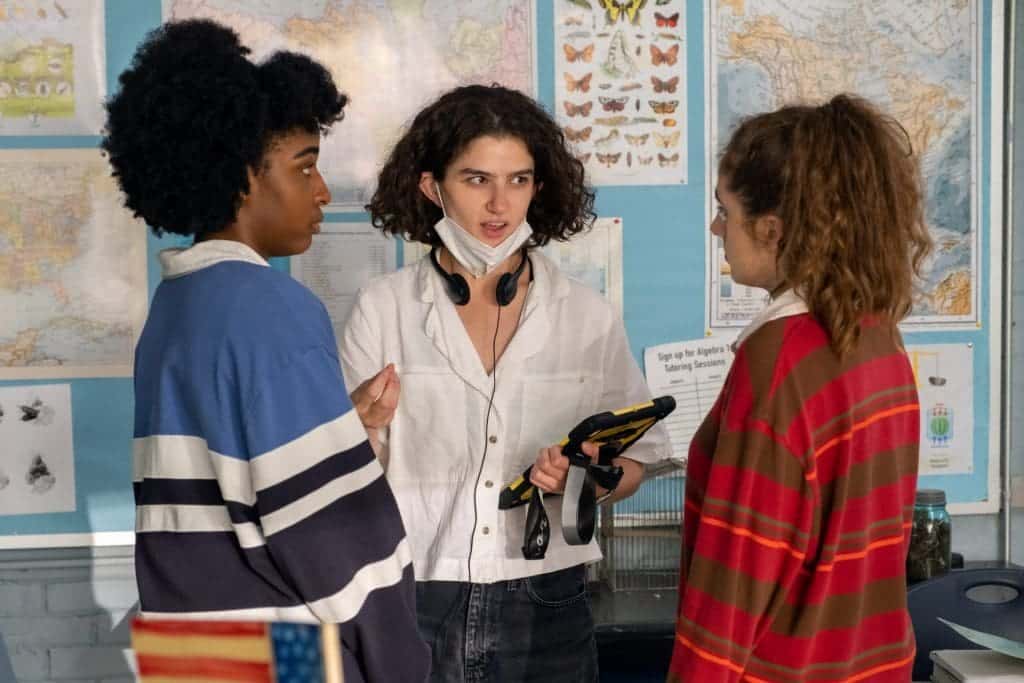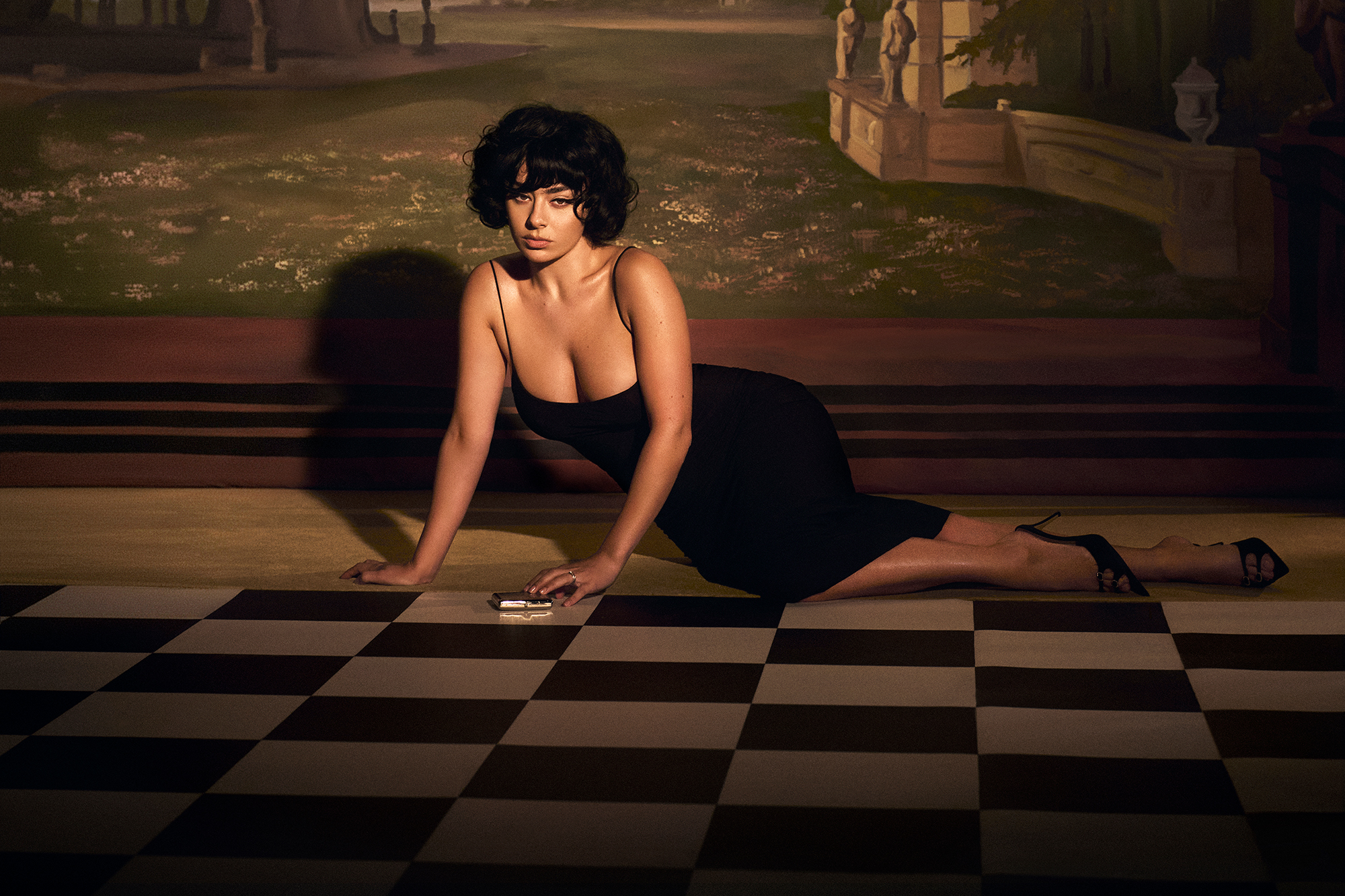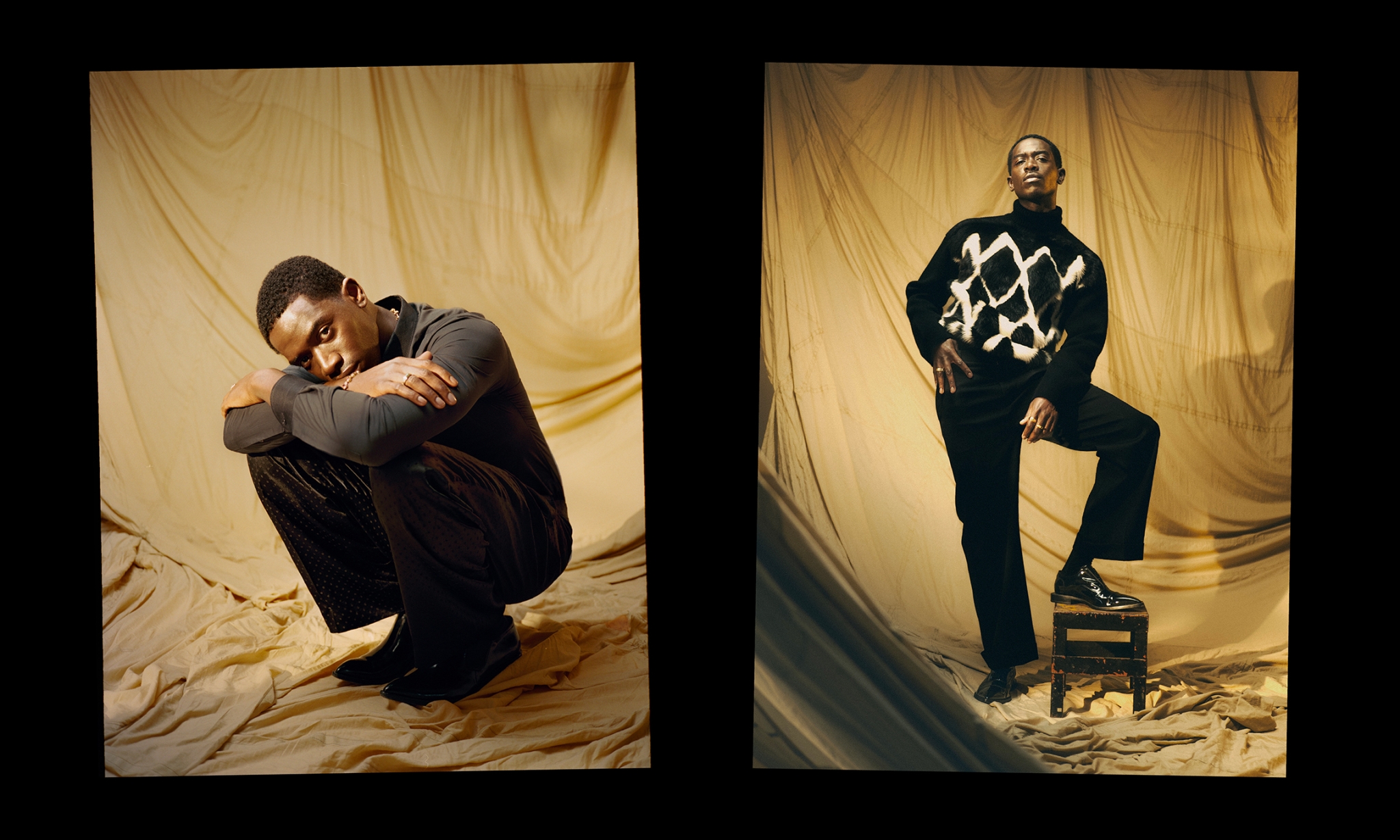
Here’s a one-line elevator pitch for the funniest comedy of the year: Two high school girls desperate to lose their virginities hatch a plan to seduce local cheerleaders by starting an all-female fight club in their school gymnasium.
The film is Bottoms, writer-director Emma Seligman’s raunchy follow up to Shiva Baby, the 2020 indie-hit that marked her and best friend–writer, comic, and actor Rachel Sennott—as bold new forces in Hollywood. As sophomore features go, Bottoms couldn’t be more of a detour from the expected, with Seligman and co-writer Sennott making the risky leap from nightmare-shiva dramedy to absurdist sex-comedy. The premise was conceived from Seligman’s yearning to see more gay characters represented in the kind of silly, R-rated romps that defined her formative years—characters that are messy, flawed, and more human as a result. For the 28 year-old filmmaker, the solution was simple: if you want something done right, you gotta do it yourself.
But don’t let its foul-mouth and balls-to-the-wall humour fool you, Bottoms is a radical new entry into the queer cinema canon, and a cult-classic in the making from two of the new wave’s most unconforming outsiders.
Sitting poolside with Seligman on a typically sun-drenched LA morning, A RABBIT’S FOOT spoke to the filmmaker about the nuances of queer intimacy on-screen, comedy in the internet era, and just how the hell she and Sennott got this film greenlit in the first place.
You started writing this film with Rachel [Sennott] over six years ago and it seems to be an explosion of both of your imaginations combined. What was it like to conceive of this thing and follow it through with your best friend?
I think every time you’re able to make something that you write it ends up being therapeutic at some point because you’re giving it so much time and energy, and there’s so much fear around whether or not it’s all worth it. To have a best friend do it with you—especially during the pandemic, during the process of not knowing whether our first film would even come out because of the pandemic—it was special to have a friendship to weather the storm with, to enjoy the highs with, and to have someone to help you during the lows. Neither of us grew up in the industry, we’re both outsiders coming in, so to have another person who’s just as naive as you in all the good and bad ways is gratifying. We meet a lot of people who are more familiar with this industry than we are, and more cynical because of it. So it was cathartic to have someone to check in with and be like, “wow, look where we are, and look where we were six years ago” every step of the way—even before we started shooting.
You really embrace the nonsensical in this film. Why was that something you both decided you needed to do to achieve your vision for this story?

Rachel’s style of humour is so absurd as a comic and a Twitter person that she just leant into that and I didn’t think twice about it. When it came to directing the movie, that’s when I had to get a grip on things tonally and execute this nonsensical style that was influenced by Rachel’s sensibilities. So that was more of a challenge, but also something I thought more about through cinematography and the colour palette and our costumes and production design. What does that absurdity mean for what era we’re placing the characters in? What references do we want to make? Whose perspective are we trying to follow? The best part about being writer and director is being able to have multiple iterations of the same movie—like a child, you get to see it grow into its own identity.
The premise of Bottoms is a hard sell—how did you get this made?!
[Laughs] No studio wanted it. And even those who supported it were like: “This will get made as an indie”. Our producer admitted to me recently that everyone was telling her to go make this as an indie, which she never shared with us before. But you just need one person to get it and understand what you’re trying to do, and take a chance on you. I think we had that with [Producers] Elizabeth Banks and Alison Small, specifically. We sent it to so many producers and I just don’t think they got it at all. Having Alison be our champion was pivotal for myself and Rachel who only come from an indie-filmmaking world and don’t know how this industry operates on a business level. Orion Pictures is doing the things that a lot of other studios claim they want to do, which is to tell more stories that are from female perspectives and queer perspectives and POC perspectives, and letting us as filmmakers tell the complicated, messy, or dark versions of our stories. It really is luck and timing, and producers making things, instead of letting their scripts sit on the shelves, and wanting people to go and see these stories in theatres.

What queer movies do you think influenced you during your formative years that found their way into this film?
The only one I had really to work from was Jennifer’s Body, which I saw when I was 14. I had seen D.E.B.S when I was a kid but not from beginning to end. I remember catching it on TV and not really understanding what it was—and probably being a little scared of it? A gay movie…and they’re fighting…and they’re spies? I wasn’t as advanced of a viewer when I watched it. The only other movies that we knew existed and we were happy about but we didn’t want to take from were the Love, Simon’s of the world. I’m so glad we’ve got to a point where we have non-depressing teen queer films. It’s such a win to have gay teens in a movie that aren’t being sent to conversion-therapy camp [laughs], though those movies have their place. I love The Miseducation of Cameron Post, but neither of those camps were where we wanted to land, so instead we pulled from straight movies, and put ourselves in them.
You’ve mentioned before that it was tough to write the queerness into Shiva Baby—what did it mean for you to be able to really show queer intimacy in this film in a direct way and, not only that, give those characters a happy ending?
It’s funny, I was just talking about this on the phone the other day…I felt so nervous being a female director doing queer sex scenes, because I didn’t want to feel like we were objectifying these female characters the way they’ve been objectified in teen sex comedies from the male perspective.
But at the same time, it’s a sex comedy! And I wanted to be able to honour the genre from the queer girl’s perspective and give the movie what it deserves: raunchiness, selfishness, shallowness; because these girls are objectifying the other girls in the movie. It was a tricky tightrope to walk, because we haven’t seen that on screen before. I had that model minority complex thinking that these characters have to be good people, but in this film they’re not good people. So, how is the horniness of these characters, and the obstacles they come across in their attempts to have sex with these other girls, specific to their identities and not just pulled from your typical sex-comedy? Sometimes when you see queer teen kisses in movies they’re just little pecks, and I asked our intimacy co-ordinator, “can they, like…make out a little bit more?” [laughs]. It definitely felt strange in a sort of way that I didn’t feel in Shiva Baby with the straight relationship—with that, I was like, “alright you guys are having sex, cool.” With this, I was like: “Does everyone feel okay? Can we be a bit more passionate, is that alright?”

A favourite early line in the movie is when Rachel says, “nobody hates us because we’re gay. They hate us because we’re gay, untalented and ugly.” Was it important to you to make the leads unpopular because they’re “losers”rather than because of their sexuality?
I’m a fan of any movies with queer characters where queerness isn’t the plot, where they just happen to be queer and dealing with what everyone else is dealing with. At a certain point I didn’t want any mention of them being gay or lesbian or queer, and didn’t want that to infiltrate the jokes. That was unrealistic, because when you’re of any identity that isn’t the norm, you talk about it a lot, with your friends especially. So, eventually I let go a little bit, and there are moments in the film that Ayo [Edebiri] improvised, where she’s talking about her high school reunion and she’s like, “I’m in a suit like the little lesbian I am.” I got scared because I didn’t want the marketing department to piece together all of the times the characters said “gay”. But I ended up deciding they can joke about being gay a little bit.
But it’s not the take-home.
Exactly. In general I don’t want to tell those stories. I think we’ve had enough of them—they earned their place, and they’ve been wonderful in terms of our progress and in terms of our representation, but, yeah, no. These characters are just losers [laughs], and it felt freeing in that way.
What kind of impact do you want this film to have in the long-term?
I hope that other queer filmmakers can push the envelope further than I did. Even shittier characters, even hornier, even more selfish. We just tried to do our best without a reference point, so I hope other filmmakers are inspired by this and are encouraged and empowered to create even messier characters, with fully elongated sex scenes and more awkward sexual interactions that I didn’t feel as comfortable executing here. But, also, I hope people feel seen and entertained. Queer audiences deserve something stupid to just enjoy.
During my second viewing of Bottoms I realised that it’s kind of built to be a rewatchable. I must have caught dozens of more jokes that weren’t even part of the dialogue, but built into the set design. How focused were you on keeping that meticulous attention to detail regarding the comedy in the film?
Most of that was written into the script! Especially the production design jokes—Rachel would write what certain signs in the background would say. I think once we executed that, my [cinematographer] and I went deep on references where there’s comedy happening on multiple focal planes. Zoolander has that a lot. Heathers has that a lot. Anchorman. So many Edgar Wright movies, like Shaun Of The Dead or Scott Pilgrim vs. The World. Wright was a big touchstone in general for the action and humour in the movie. A lot of it was also supposed to be setting up who the guy in the cage was, or the penis-mascot, and other things that I hope people catch. I really loved this joke that we left on the cutting room floor where there’s this blowjob happening in the back of the classroom, and we had a direct shot of that to, you know, just establish the world and the setting [laughs]. I miss those jokes, but now I think it’s a lot funnier for people to catch those moments during a rewatch.

This is the first film I’ve seen in a long time that nails the energy of internet humour without ever “doing” internet humour: without the cliches or self-references. What do you think other (perhaps older) filmmakers don’t understand about how our generation might approach comedy?
I can’t speak on what other generations don’t understand, because I think when you’re inside your culture, you’re not analysing what makes your generation laugh. But what I can say is that satire feels timeless, and joking about whatever issues are affecting your current generation will always land a little bit more with the people who are being influenced by whatever it is you’re trying to poke fun at or criticise. I think some of our jokes are more specific to what’s going on with young people right now. Though we always, always, wanted to avoid having phones and social media in the movie because we didn’t want to slip into telling jokes from an online/young Gen-Z perspective. We started writing this six years ago, and we knew that by the time this movie came out that social media and the world would look completely different. Humour on the internet changes so rapidly to the point where I just don’t know how anyone makes a movie where the kids are active on social media and feel confident that in two years the jokes will still land. That was a decision we made early on, and we stuck by that.
Why were Ayo and Rachel the best two actors to execute that?
Ayo and Rachel are comedians that came up on Twitter, so I think they have a pulse, not with internet slang and jokes, but when it comes to being satirical and commenting on the times we’re in. The best comics do that, and the most in tune comics with the world do that. That’s in their blood as good comedians. Rachel infused the script with jokes that she would otherwise tweet, and when they were improvising it was a continuation of that. Ayo improvised the line, “that’s my favourite way to be an ally: you just say you’re doing something and then you don’t do any of those things”, and I think that kind of line comes from being a comedian who is on the internet and aware of what’s happening in the world.

One of the things that I admire the most about Bottoms is that it is worlds away from the style we see in Shiva Baby, though the writing and directing is still so sharp. Do you mean to keep challenging yourself as you move forward with future projects?
I just want to be able to tell more Queer and Jewish stories in other genres. The way I came into movies wasn’t by being a photographer or growing up making movies with my friends—I was just someone who watched films constantly. I come from a family of movie buffs who aren’t in the industry, therefore I just want to continue making movies in all those genres that I loved as a kid, hopefully from Queer and Jewish perspectives, to make up for lost time and see these characters in big movies that we didn’t get to see as kids. This movie was a challenge in terms of the jump, but also really exciting. I want to continue to do that with a real action movie, or a totally committed genre horror movie, or a sci-fi, or a western. Life’s simply too short not to give it a try. END.





